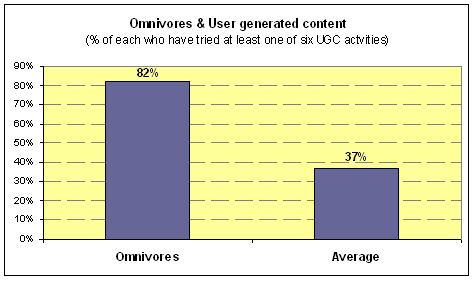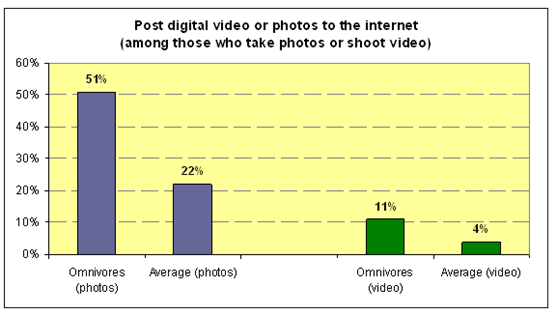Omnivores are active participants in shaping cyberspace, particularly by taking, sharing, and downloading video content.
This small group of ICT users – it makes up 8% of the general population – is the most elite and gets the most attention from technology producers and the media. Its members are distinguished by what they do with digital information. They have plenty of technology at hand, and they use it to post, manage, and share content on the internet. To a degree that sets them apart from other technology users, video is central to how Omnivores use the internet. They are more likely than others to have a web camera, download video from the internet, watch television programming on a device that is not a TV, and use their cell phones to take or watch video.
Omnivores have a richly participatory relationship with digital content and a strong sense that information and communication technology makes life easier and offers important creative tools. For Omnivores, ICTs are a principle means for pursuing their hobbies and staying in touch with their social networks.
Assets
Omnivores move a lot of bits, whether it is content they create for the web, offline material that they digitize for the internet, or material they pass on from those in their social networks. For these reasons, they are drawn to devices that help them manage digital audio and video content. Fully 92% have a digital camera, 69% have a video camera, and 51% have a web cam—all figures well above average and exceeding those for other groups. Also, 70% have iPods or MP3 players—three and one-half times the average and further evidence of this group’s preference for managing digital content.
With their orientation toward video, people in this group are more likely to have a digital video recorder (DVR) (47% to 18%), even though they watch less TV than the average American. Omnivores are also more likely to have a cell phone that can play video (39% versus the 13% average for cell phone users) and shoot video (58% versus 22%).
With all this technological capability, it is no surprise Omnivores have the network assets to go with it. Fully 89% have high-speed internet connections at home, and nearly all (97%) have broadband either at home or at their workplace.
Activities
Omnivores are not only more likely than other groups to download audio or video from the internet (59% have downloaded video and two-thirds have downloaded audio content), but also to remix this content and then post it to the internet. Some 30% of this group has done this, far above the 9% average for all ICT users. Overall, 82% of Omnivores has undertaken at least one of the six activities related to user-generated content:
- Share something online that you created yourself, such as your own artwork, photos, stories, or videos (55% of Omnivores)
- Post comments to an online news group or website (55%)
- Create or work on your own webpage (45%)
- Create or work on webpages or blogs for others, including friends, groups you belong to, or for work (40%)
- Take material you find online—like songs, text, or images—and remix it into your own artistic creation (30%)
- Create or work on your own online journal or weblog (34%).

They also use their extensive technological capacity to try leading-edge applications. Nearly two-thirds of them (57%) have watched a TV program on a non-TV device, nearly five times the average of 13%. They also take radio to different devices; 84% have listened to radio on a device other than a home or car radio (the national average is 24%). In addition to all the other functionality in their cell phones, close to two out of three of Omnivores (67%) rely on their cell phones for most of their calls, the highest of any group and above the average of 39% for all cell phone users.
57% of Omnivores have watched television on a non-TV device, almost five times the average.
Their biggest behavioral differences relate to their focus on video. Fully 86% take digital pictures and 51% of those who take digital pictures post photos to the internet—the most of any group and well above the 22% average. More than half (57%) record their own video (twice the average) and, 11% of these post their videos on the internet—again the highest rate of any group. And they are the heaviest players of video games. Some 62% play a video game at least a few times a month, and of Omnivores who have ever played a video game, 50% have played with someone online.

Attitudes
Omnivores see information and communication technology as a means to share their creativity and pursue their hobbies. Two-thirds (68%) say IT has improved “a lot” their ability to pursue their hobbies or interests, far exceeding the 28% average. A similar number (69%) says that IT improves how they share their ideas and creations with other, a sharp contrast to the 28% average. And Omnivores seem unburdened by technology and its consequent connectivity to the world: just 10% say they suffer from information overload (against the 27% average), and 78% say they like that cell phones and other mobile devices make them more available to others (versus 48% of all respondents).
Cyberspace is a platform for creativity for Omnivores; 69% say IT helps them a lot to share their ideas and creations.
Demographics
Omnivores make up 8% of the population. They are young, ethnically diverse, and mostly male (70%). The median age is 28; just more than half of them are under age 30, versus one in five in the general population. Over half are white (64%) and 11% are black (compared with 12% in the general population). English-speaking Hispanics make up 18% of this group. Perhaps unsurprisingly, many (42% versus the 13% average) of Omnivores are students, and many undoubtedly have access to high-speed and wireless networks at school.




